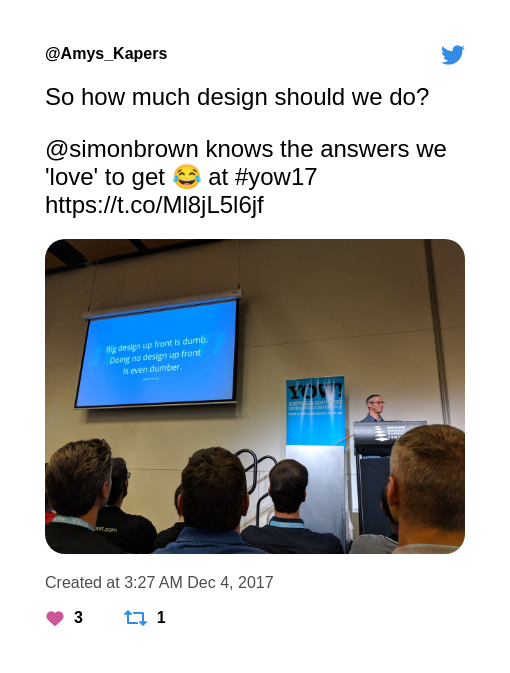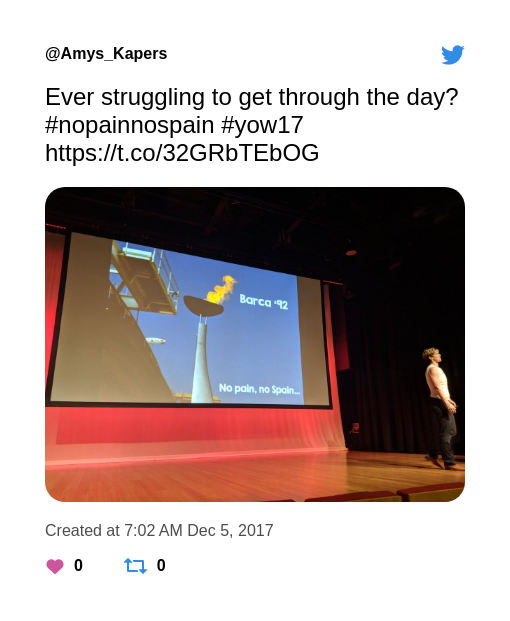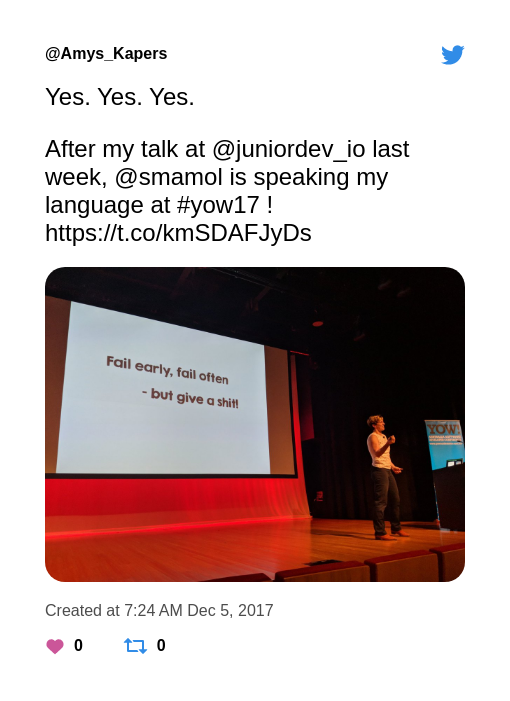JAOO! for YOW! Brisbane!
So this year I was lucky enough to get the chance to attend YOW Conference in Brisbane. As my first full two-day and first inter-state conference, as well as knowing the standard of speakers they have attending, my expectations were high but they’ve been unbelievably blown away.
Firstly, I’d like to give a big shout-out to everyone who spent time and effort making this happen. I’ve found this year that it’s no mean feat to put together a local presentation night, so to put together a multi-city, multi-day conference with 39(!!!) speakers from all over the world is a feat I’d expect of someone with time-turner and at least one decent superpower.
Cloud Data Pipelines for Genomics from a Bioinformatician and a Developer
Lynn Langit and Dr Denis Bauer
Big data is something I’ve heard a lot more about in the past few, years but this amazing opening keynote (with two kick-ass ladies teaming up) was a great chance for me to see if in action.
I’ve always been a little interested in Biology and Genetics, so it was great to see two different areas of interest collide (although, massive props to the ladies who are able to master BOTH fields).

While most of the technical aspects went a little over my head (ok, a lot over my head), I was pleasantly surprised to understand the concept behind mapping genomes to determine different areas of similarities to help us further understand diseases such as ALS and cancer. The sheer amount of data that is needed to deal with is unfathomable and the system and architecture they’re using is utilising some of our best new technologies in the industry.
There was also a great spin to the entire talk, as although they weren’t able to use actual data (for obvious reasons), I had no trouble in following the genetic markers that are attributed to being a hipster (I should get mine checked, but i think I’m ok) and seeing the entire system in action.
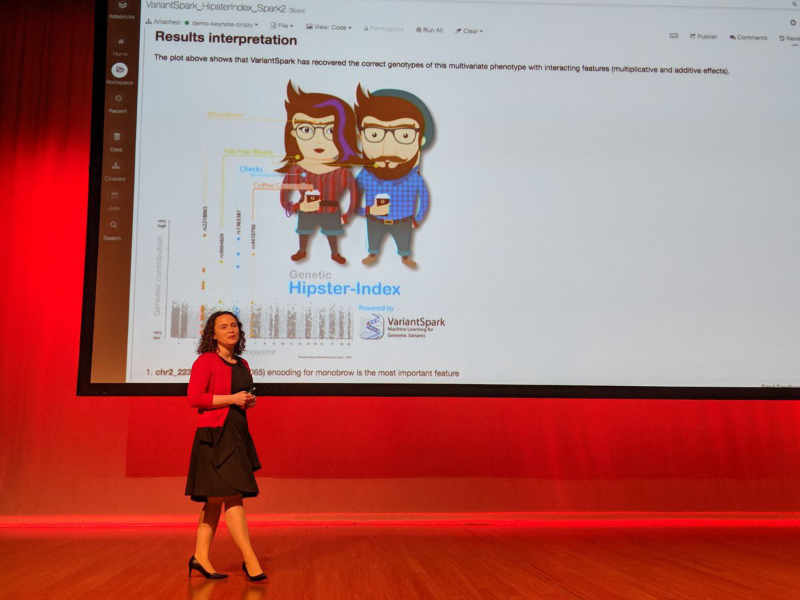
They then moved on, because not only are they looking further into the genetic markers of ALS, but serverless technology is now being used to help increase the accuracy of CRISPR, so that hopefully one day we can work on eliminating debilitating genetic diseases such as HCM (Hypertrophic cardiomyopathy).
How Agile Screwed Up Product Ownership and 5 Things You Can Do to Fix it
Jeff Patton

I’ve briefly worked in (loosely) agile environments, and I’m always interested to see what others’ of this methodology. I’m actually yet to find anyone who can claim that they actually follow agile completely, but you’re also not really agile unless you change things where necessary. Jeff’s talk was incredible because he live sketched his talk, which was an entire new kind of entertaining.
We always seem to run into issues when blindly following instructions (I feel dystopian novels should have taught us otherwise) and a lot of the issues that seem to stem from Agile environments can often be attributed to this as well. Just because something works well for one team, doesn’t mean it will for another.
Stop treating the product owner like the customer
One big issue we have is treating the product owner like the customer, which is probably a concept most devs are familiar with. When working in customer service, “the customer is always right (even when they’re wrong)” is often a frustrating concept to deal with; and when working in development we sometimes have the same issues with a product owner (particularly when they’re not technical). How many times have you been given instructions or deadlines by someone who doesn’t understand the work that you do?
Don’t just assume that you’re working on something useful, meaningful or for the greater good
We also need to spend less time believing that we’re working for the good guys, or on something life-changing (yes, some people actually are). Just because you have an idea, doesn’t actually mean it’s a good one or worth spending time and money on. Having spent time working in an agency, I’m super familiar with this concept. The number of phone calls and emails we received from people who’d had an idea for an app that they needed help making; most of the time their idea was copying (eg. I want to re-make Groupon), no good, or they got upset when we told them it would cost money to make (“but it’s going to make so much money, can’t you do the work for free and we’ll pay you when it goes viral?!).
Lastly Jeff touched on some very important topics (and ones that are close to my heart) with the following points:
Stop spending so much time at the office
and
Stop hiding work from the team
Recently it’s surfaced how many companies have unhealthy environments and how many people in this industry inevitably burnout at some point (having burnt out twice before I even turned 24, this is something I think is a really important topic to address) and there are far too many people who think this is ok. Make sure that you’re spending time away from work (and that means properly away, not just working at home), whether it’s downtime by yourself or taking the chance to see your friends and family. And when you’re at work, don’t hide what you’re working on, make sure it’s visible. I’ve been in roles where co-workers didn’t really know what I was working on and had the impression that I was slacking off; little did they know I was working 10+ hour days and completing the job of several people. If the work isn’t visible, it also can’t be taken into account when scheduling work in and you’ll find yourself working 80 hours in a week.
Estimates or #NoEstimates?
Woody Zuill
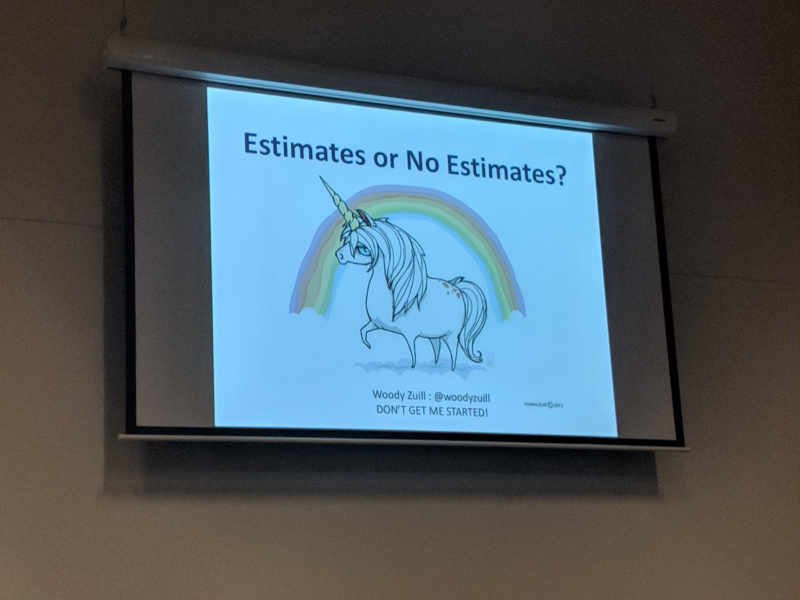
As a freelancer, I’m often plagued by the law of estimates (especially when I don’t estimate properly), so the title alone of Woody’s talk sounded interesting to me. To top it off, his wife is also a children’s book illustrator and is responsible for all his slides. They weren’t in any way relevant to the slide content, but I love getting a good giggle out of imagery being used in presentations.
The first thing Woody did was get us to write a one word summary of an estimate on a sticky note and put it up on the wall. Not surprisingly, we all seemed to use similar words and themes with negative connotations (restrictions, limit, pain, guess), which is something that seems to be repeated at his talks all over the world. Apparently some people don’t listen to instructions though, when running this same exercise with a group of managers and execs, Woody found that most of them filled the post-it with text and didn’t listen to theone word limit.
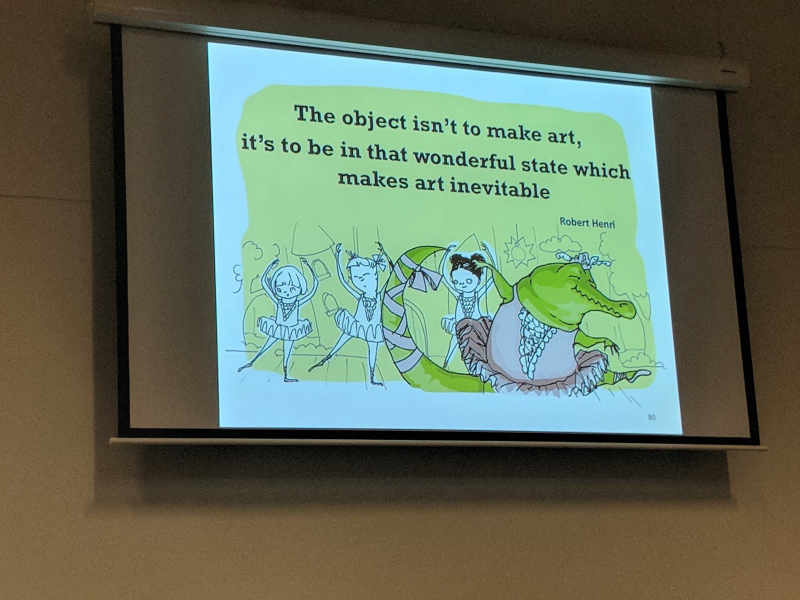
“It ain’t so much the things we don’t know that get us into trouble, it’s the things we do know that just ain’t so” - Mark Twain, Artimus Ward, Will Rogers (or someone else)

Estimates are a useful tool (when used properly), unfortunately sometimes they’re not necessarily the right option or the solution to a problem. If working on your estimates aren’t solving your problem, maybe give something else a go.
The definition of insanity is trying the same thing over and over again and expecting a different result.
Software Architecture for Developers
Simon Brown
Normally when people starting talking architecture, I get a little lost, I’m perfectly happy to leave that to someone else. Simon’s presentation was very well done however and I found myself able to follow and relate to the entire talk.
We need to make sure that we’re planning ahead instead of just running at a problem head-first; but at the same time we also need to stop spending so much time planning at the start before we get into anything. Small iterations are great for helping to work through a project and get a better idea of issues that may arise quickly. We can plan for how things will work but often it doesn’t happen that way.
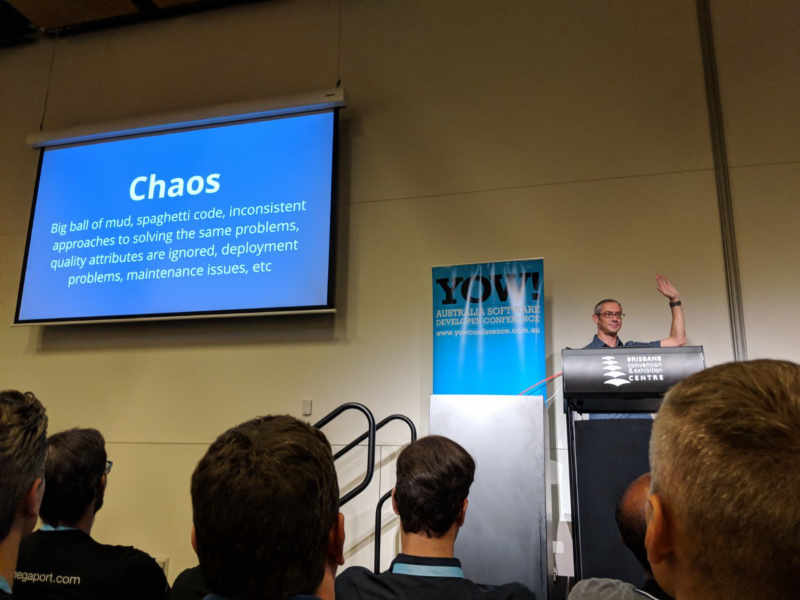
Honestly, I can’t really summarise Simon’s presentation anymore than his slides did.
Quantifying the Influence of Beautiful Environments on Human Well-Being
Chanuki Illushka Seresinhe
We already know that there is a correlation between happiness and your surrounding, and there have been several scientific studies on how being around greenery helps you concentrate and stress less. Chanuki has been using machine learning, and crowd sourced data to actually work out what it is that we like to see in our surroundings.
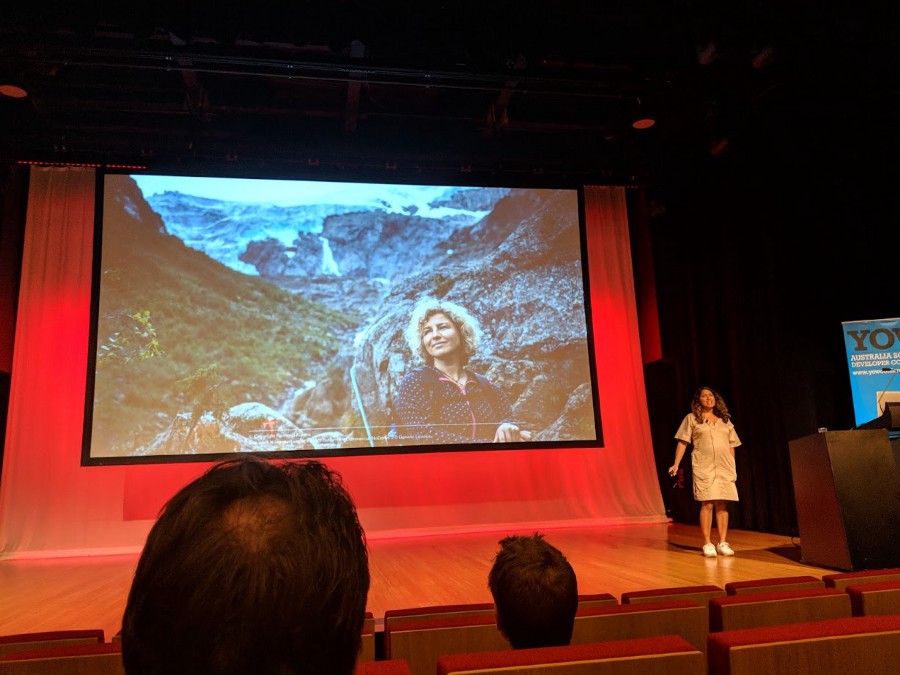
We’ve been working off the assumption that green is good, but there are different levels of green. If there’s a small square of green grass in the middle of a dingy apartment complex, do we automatically feel relaxed simply because we can see green?
The levels she’s been able to analyse this data was incredible. And the different things we’re able to do with it are exciting. One day we may even be able to use a machine to design buildings and complexes and use the data to work out what people actually want, rather than have someone assume they know what we want.
Machines that Learn Through Action: The Future of AI
Julie Pitt
We’re starting to hear more and more about AI (much to the dismay of technophobes and conspiracy theorists), but the work still has a long way to go before we need to worry about a robot uprising.
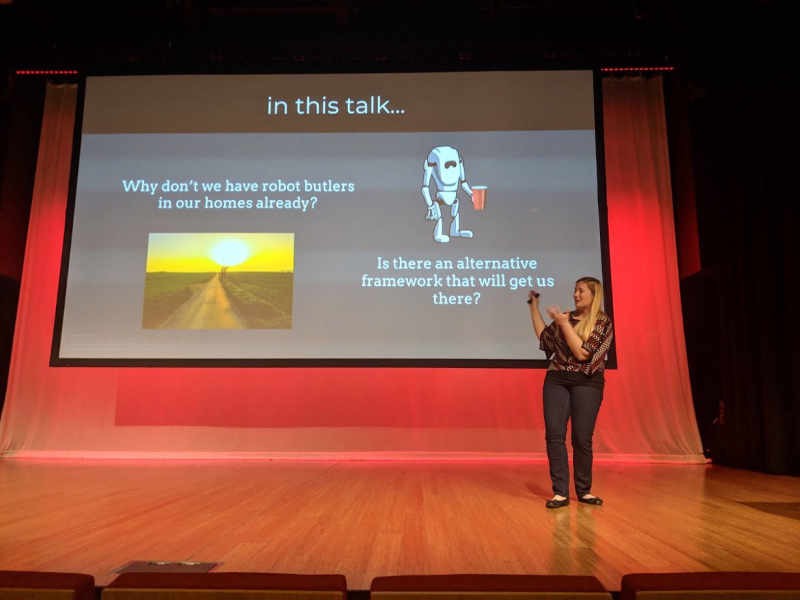
While most of the math (and technology) went way over my head, Julie walked us through the process of teaching a robot how to perform a task that we perceive as simple, such as fetching a drink of water. To simply get the robot to work, you need to teach it about standing, balance, maneuvering and watching out for risks such as stairs, balcony edges and the dog.
The field of AI and Machine Learning is a very complex (and therefore often scary) one, but Julie did an amazing job at walking us all through the (very simplified) process of how you teach a machine how to move, make decisions and act. As a mathematically minded person, I also enjoyed that she was able to give us the formula for surprise (although I was completely lost).
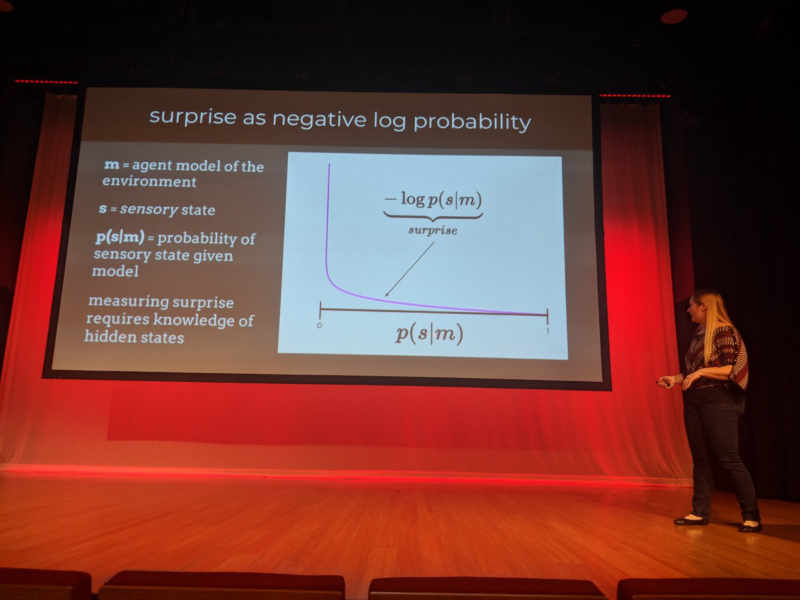
Using EEG and Machine Learning to Perform Lie Detection
Jennifer Marsman
Turns out that Jennifer has an amazing job, and somehow managed to convince her boss that an EEG headset was a work related purchase. While using lie detectors isn’t massively reliable, the ability to correctly read the results can also skew the results. So what if you could teach a machine to recognise the different traits and work out if someone was telling the truth?

Jennifer has been using her new toy to teach a machine to perform lie detection using data, and gauging peoples’ reactions when they were hearing the question, beginning to answer the question and when they had answered them. She managed to talk her husband into being her first guinea pig and also cornered her boss with a camera crew and her new project, but the work she’s doing is pretty impressive. We might not be able to get away with just using a thumbtack in our shoe for much longer.
Principles of Play and Programming
Linda Liukas
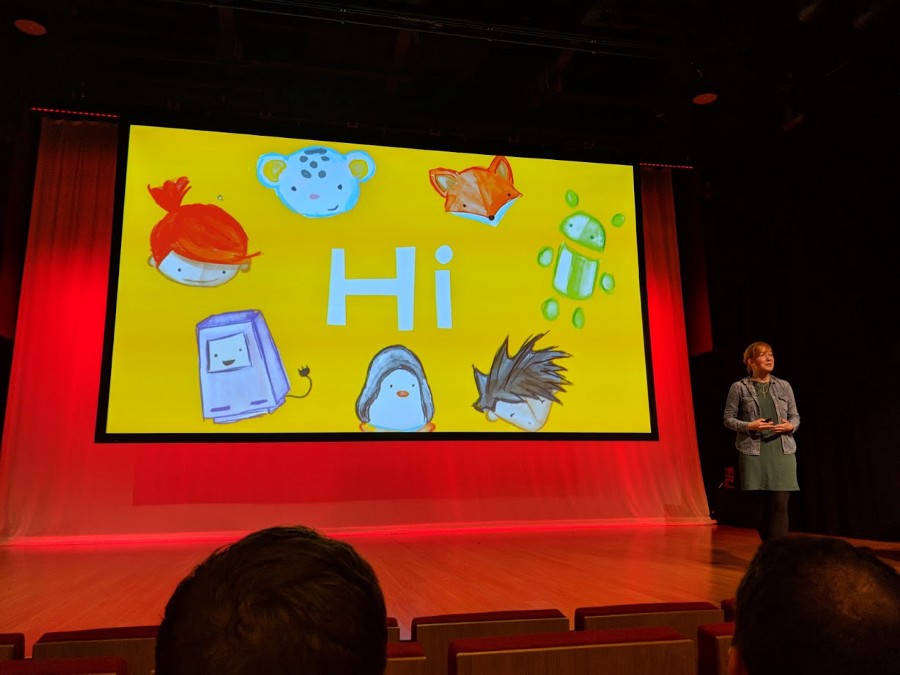
There are so many things I want to say about Linda’s talk, but I’m still having difficulty finding the words to describe it. Five minutes after getting out of her talk, two of us were on the phone to every bookstore in Brisbane and spent the lunch break traipsing around buying every copy we could find.
Programmer by nature, 3 years ago Linda decided to start writing children’s’ books that introduced kids to coding. Not sure how it would go, she was fairly confident that the community of kids and parents she’d talked to in Finland would be meet the Kickstarter goal of $10,000 and she’d be able to publish her book. After 3 and half hours, she smashed the goal and managed to raise 3800% of her funding goal, contributing to 20% of Finland’s book exports that year.
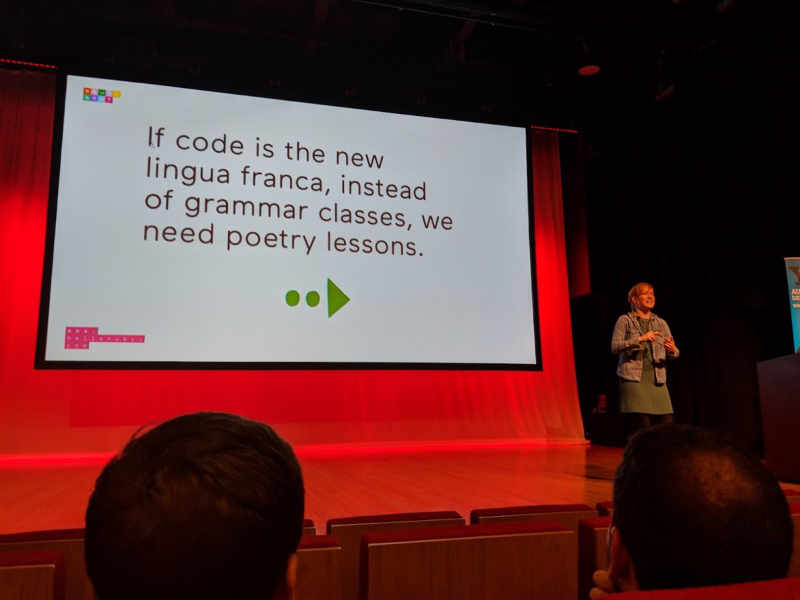
Linda took us on a journey with Ruby, a smart (sometimes too smart for her own good), bright young girl as she explores the world and learns about programming and technology.

When working with children, or writing books for them, we often find that things are over-simplified. Linda has managed to capture the core concepts of programming, and explain them them to children in a way that makes them feel like they’re being treated like adults but they’re still able to understand. I spent a couple of years studying engineering, but in 5 minutes she managed to explain logic circuits in a way that none of my Electrical Engineering lecturers every could, and she did it with amazing drawings (because apparently she’s not enough of a superstar already, she can draw as well).
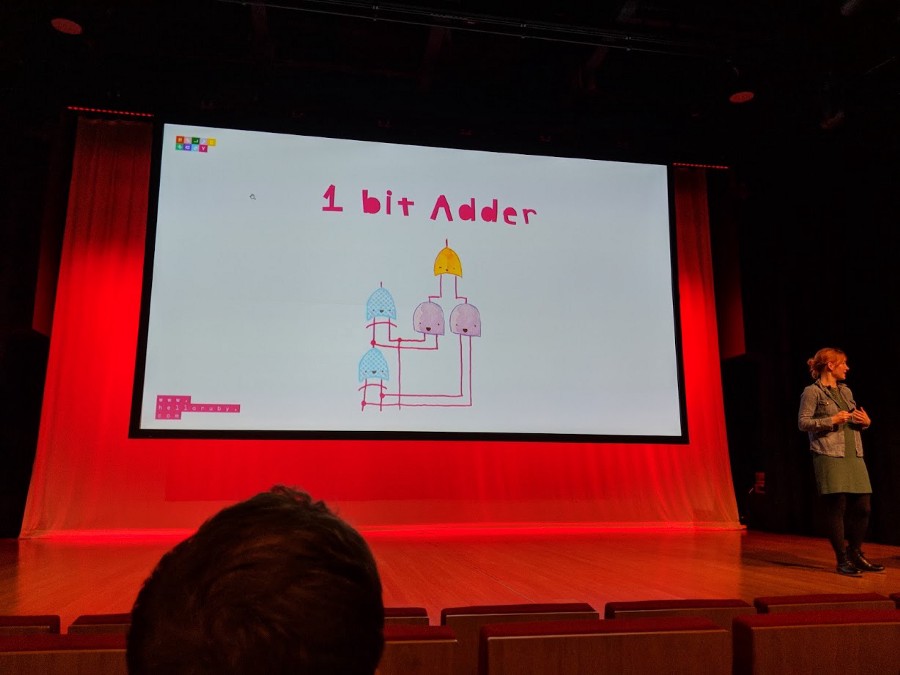
I convinced my family that a set of children’s books was an appropriate present for a 23 year old, and I took great delight in getting to adventure more into the world of computers with Ruby and Linda. Children have an unbelievable imagination, and the things they can do with it are hard to fathom. They’re the future of tech, and we need to make sure that they are prepared for. But just because they need to learn, doesn’t mean that they can’t have fun while they do it.
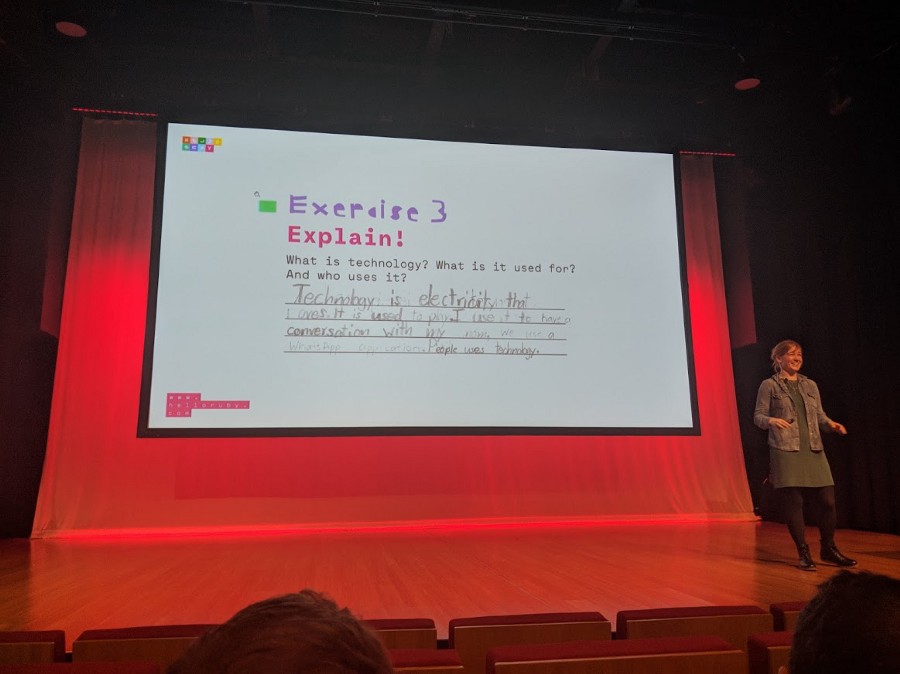
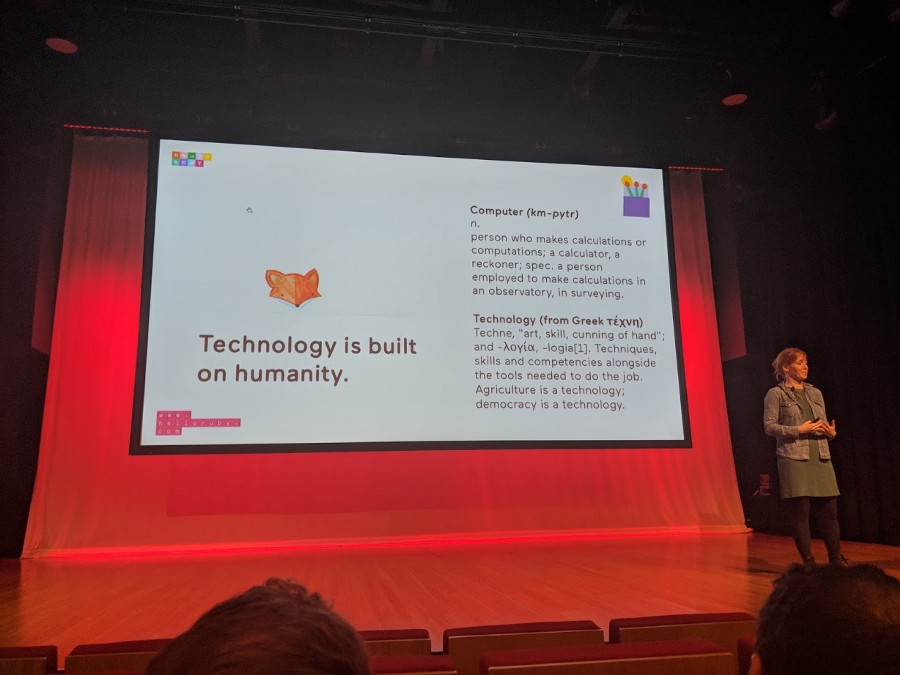
Introducing kids to code through hardware using C++
Sara Chipps
Sara pointed out, that most of us have jobs because of teenage girls. This demographic are the trendsetters and customers of all the big tech companies. It’s because of products like Facebook, Snapchat and Instagram that so many devs have jobs, and without the teenage girl demographic, the products would be severely lacking.
To help encourage these trendsetters to get more interested in tech, Sara developed and launched Jewelbots. These cool funky bracelets are customisable, so you can set it up to flash different colours when a friend comes within a certain distance as well as use it to send secret coded messages to each other.
I felt especially lucky to get to see Sara Chipps talk in Brisbane, because for the Brisbane conference only, we had a special guest. Sara was joined by 8 year old Clara who has been coding her Jewelbot in C++. It was amazing (and a little intimidating), to sit and watch an 8-year old give a great presentation AND live coding demonstration, without losing her patience when the jewelbot refused to connect (as we all would do in that situation).

It was great to see someone else recognise the importance of children in tech (they are our future), as well as encouraging more girls to get involved in coding. Sara also raised the other important point that kids remember, but we’ve forgotten:
Any sufficiently advanced technology is indistinguisable from magic
Dynamic Reteaming: The Art & Wisdom of Changing Teams
Heidi Helfand
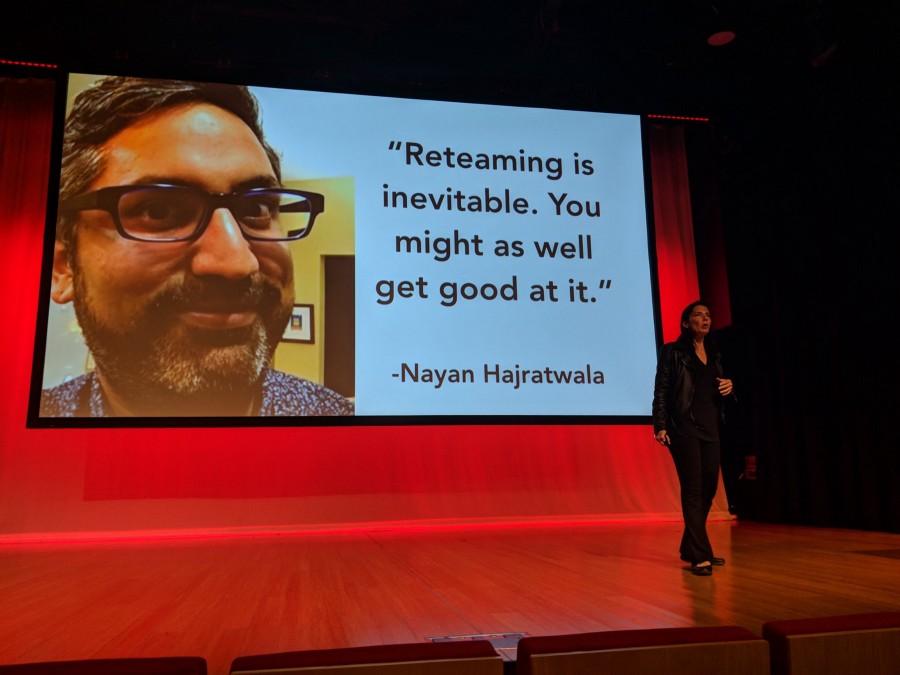
These days everything is happening so fast and changing so quickly, most of us don’t have the same job for very long (and even if you do, your team probably changes quite a bit around you). While it’s often hard to no longer be working with your friends, or being comfortable knowing your job inside out, this change can also be a great thing. It stops you from stagnating, and helps you move and grow in your career.
When we get comfortable in our job and our team, we often don’t extend ourselves and rely too much on the people around us. It’s in situations like this that we end up with lots of “people knowledge”, and although it’s great to know that you’re the expert in a particular area, that also means that the team is dependent on you being there. I’ve been in this situation before and had a co-worker point out that although I can’t get fired, I also can’t get promoted.
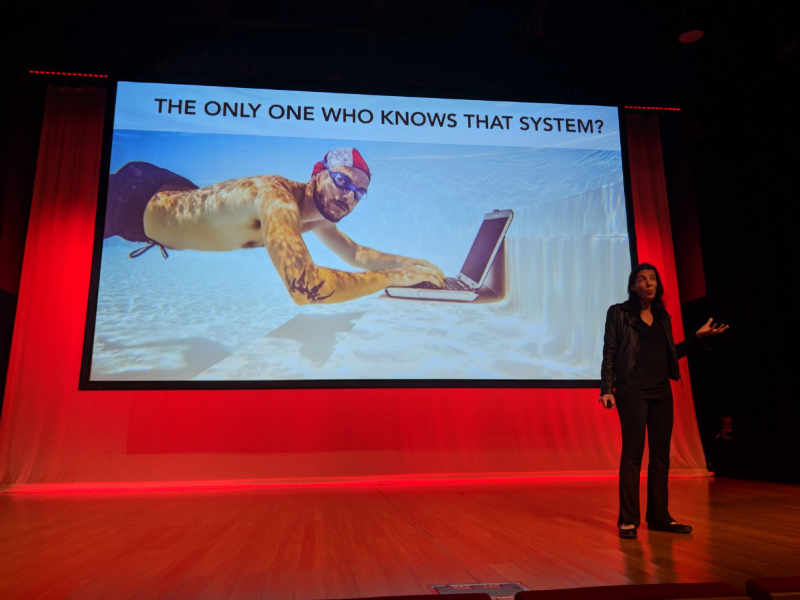
I’ve changed teams (and companies) quite a bit in the past few years, and have found that it’s a great way to learn new and different things in the industry. It’s because of this ever changing environment that I’ve learnt so many new things and expanded my skillset (and continue to do so). If I ever find myself working in a team again, I’m definitely going to suggest some of Heidi’s strategies.
The Bait & Switch of Open Source
Katrina Owen

One of the things I found really interesting about Katrina, is how many things that have seemed to just happen to her. I’m still not entirely sure how she managed to accidentally move to Paris for 7 years, but the fact that she managed to accidentally build one of the biggest code learning platforms is pretty impressive.
While teaching, Katrina found a gap and started Exercism.io, and all of a sudden it went viral and she found that she had way too much on her hands.

While Katrina mostly talked about her journey and what we don’t think about in the world of open source, it was also good to remember that these same principles can easily relate to a lot of different areas of life. And if nothing else, I like listening to people who remind me that although code can be difficult at times…
Peopling is hard
How the Olympics Can Make You a Better Person
Sandy Mamoli
One of the things that led me to Sandy’s talk, was how you manage to move from a career as a professional athlete, to a programmer, and she did not disappoint.
Getting to the Olympics is obviously something that takes a lot of dedication, resilience and dedication, and thankfully that can then be useful in your life after the sport.
She also raised a good point to:
Be the worst player on the best team that will still accept you
If you’re the best player on your team, you have less of a chance to learn from those around you (although most of us learn no matter where we are). If you are the worst person on the team, there are so many more people around us who can teach us what they know, until eventually you’re the best person on the team (and then you find another team where you’re the worst player again).
This point also tied back into Heidi’s talk, in knowing when it’s time to leave. We don’t have to stay in the same team forever, and sometimes the change is what we need.
The week before I went to YOW, I also got the chance to talk about Failure and my experiences with it. So it was great to see Sandy (and a few others) talking about a topic that’s really important and something we need to reassess our point of view on.
All in all, Sandy’s talk gave us some excellent insights into surviving our careers and life, as well as a good chance to reminisce about some really bad hair choices with her photos. There were a few other points that I won’t repeat here (I’m trying to control my language on my blog), but I may include her slides below to share them.
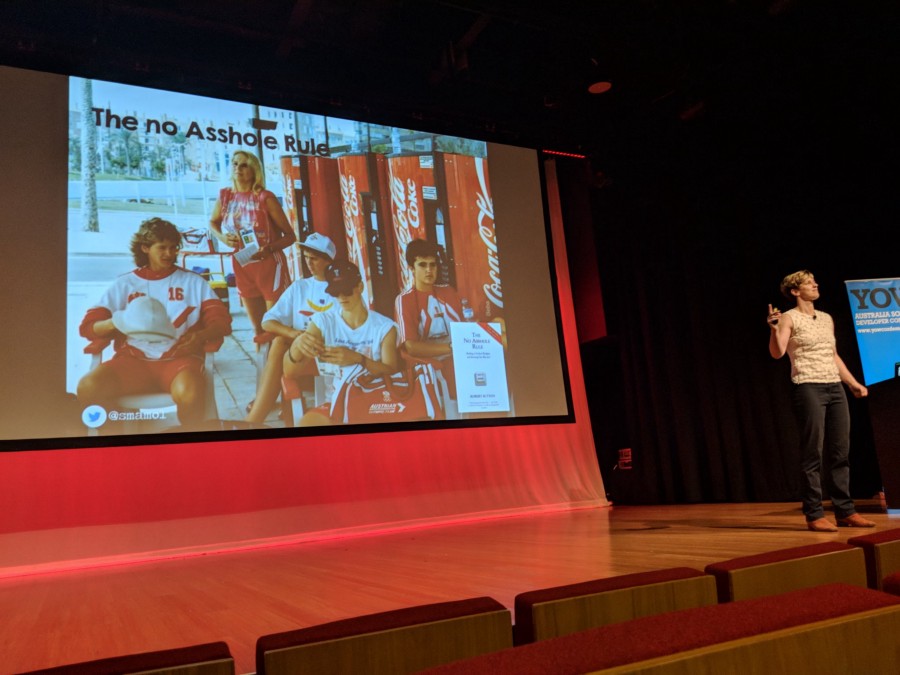

I really can’t stress how important I think conferences are for our industry. It’s an amazing chance to meet new people and network, to hear from others in our industry and learn about the new things that people are doing.
YOW do an amazing job with their conferences, both in the calibre of speakers that they had, as well as their efforts in encouraging greater diversity in their events and the industry as whole. I had a great time at YOW and will definitely be going back.

